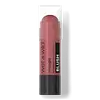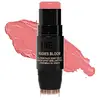What's inside
What's inside
 Key Ingredients
Key Ingredients

 Benefits
Benefits

 Concerns
Concerns

 Ingredients Side-by-side
Ingredients Side-by-side

Polybutene
Ozokerite
Emulsion StabilisingEthylhexyl Palmitate
EmollientMicrocrystalline Wax
Emulsion StabilisingSynthetic Fluorphlogopite
Silica Dimethyl Silylate
EmollientSynthetic Wax
AbrasivePhenoxyethanol
PreservativeTocopheryl Acetate
AntioxidantTocopherol
AntioxidantTin Oxide
AbrasiveHelianthus Annuus Seed Oil
EmollientMica
Cosmetic ColorantCI 77891
Cosmetic ColorantCI 75470
Cosmetic ColorantIron Oxides
CI 16035
Cosmetic ColorantCI 42090
Cosmetic ColorantPolyglyceryl-2 Triisostearate
EmulsifyingHydrogenated Polyisobutene
EmollientPolybutene
Mica
Cosmetic ColorantCeresin
Emulsion StabilisingSynthetic Wax
AbrasiveOctyldodecanol
EmollientMicrocrystalline Wax
Emulsion StabilisingCaprylic/Capric Triglyceride
MaskingDipentaerythrityl Hexahydroxystearate/Hexastearate/Hexarosinate
Skin ConditioningSorbitan Sesquioleate
EmulsifyingPolyhydroxystearic Acid
EmulsifyingEthylene/Propylene Copolymer
AbrasiveEuphorbia Cerifera Wax
Phenoxyethanol
PreservativeGlyceryl Caprylate
EmollientTocopherol
AntioxidantCI 77891
Cosmetic ColorantIron Oxides
CI 19140
Cosmetic ColorantCI 15850
Cosmetic ColorantCI 45410
Cosmetic ColorantCI 42090
Cosmetic ColorantPolyglyceryl-2 Triisostearate, Hydrogenated Polyisobutene, Polybutene, Mica, Ceresin, Synthetic Wax, Octyldodecanol, Microcrystalline Wax, Caprylic/Capric Triglyceride, Dipentaerythrityl Hexahydroxystearate/Hexastearate/Hexarosinate, Sorbitan Sesquioleate, Polyhydroxystearic Acid, Ethylene/Propylene Copolymer, Euphorbia Cerifera Wax, Phenoxyethanol, Glyceryl Caprylate, Tocopherol, CI 77891, Iron Oxides, CI 19140, CI 15850, CI 45410, CI 42090
 Reviews
Reviews

Ingredients Explained
These ingredients are found in both products.
Ingredients higher up in an ingredient list are typically present in a larger amount.
Ci 42090 is a synthetic dye created from petroleum. It is used to give a bright blue color to cosmetics, medicine, and food.
Ci 77891 is a white pigment from Titanium dioxide. It is naturally found in minerals such as rutile and ilmenite.
It's main function is to add a white color to cosmetics. It can also be mixed with other colors to create different shades.
Ci 77891 is commonly found in sunscreens due to its ability to block UV rays.
Learn more about CI 77891Mica is a naturally occurring mineral used to add shimmer and color in cosmetics. It can also help improve the texture of a product or give it an opaque, white/silver color.
Serecite is the name for very fine but ragged grains of mica.
This ingredient is often coated with metal oxides like titanium dioxide. Trace amounts of heavy metals may be found in mica, but these metals are not harmful in our personal products.
Mica has been used since prehistoric times throughout the world. Ancient Egyptian, Indian, Greek, Roman, Aztec, and Chinese civilizations have used mica.
Learn more about MicaMicrocrystalline Wax is created by de-oiling petroleum. It is highly refined and purified before being added to cosmetics.
Microcrystalline Wax is used to enhance the texture and create even consistency. It helps stabilize a product by preventing ingredients from separating.
Phenoxyethanol is a preservative that has germicide, antimicrobial, and aromatic properties. Studies show that phenoxyethanol can prevent microbial growth. By itself, it has a scent that is similar to that of a rose.
It's often used in formulations along with Caprylyl Glycol to preserve the shelf life of products.
Polybutene is used to help control the viscosity of a product. This just means it helps adjusts the texture.
It is a polymer and does not get absorbed into the skin due to its large size.
Studies found this ingredient did not irritate skin in concentrations below 15%.
Learn more about PolybuteneSynthetic Wax is created from fossil fuels such as natural gas. It is used to enhance texture, adjust pH, and as an occlusive.
It may also be used as an abrasive ingredient to exfoliate the skin.
Synthetic Wax may not be fungal acne safe.
Learn more about Synthetic WaxTocopherol (also known as Vitamin E) is a common antioxidant used to help protect the skin from free-radicals and strengthen the skin barrier. It's also fat soluble - this means our skin is great at absorbing it.
Vitamin E also helps keep your natural skin lipids healthy. Your lipid skin barrier naturally consists of lipids, ceramides, and fatty acids. Vitamin E offers extra protection for your skin’s lipid barrier, keeping your skin healthy and nourished.
Another benefit is a bit of UV protection. Vitamin E helps reduce the damage caused by UVB rays. (It should not replace your sunscreen). Combining it with Vitamin C can decrease sunburned cells and hyperpigmentation after UV exposure.
You might have noticed Vitamin E + C often paired together. This is because it is great at stabilizing Vitamin C. Using the two together helps increase the effectiveness of both ingredients.
There are often claims that Vitamin E can reduce/prevent scarring, but these claims haven't been confirmed by scientific research.
Learn more about TocopherolThis ingredient is a combination of red, black, and yellow iron oxide pigments. This combination of colors is usually found in foundation, because it results in a "skin" color.